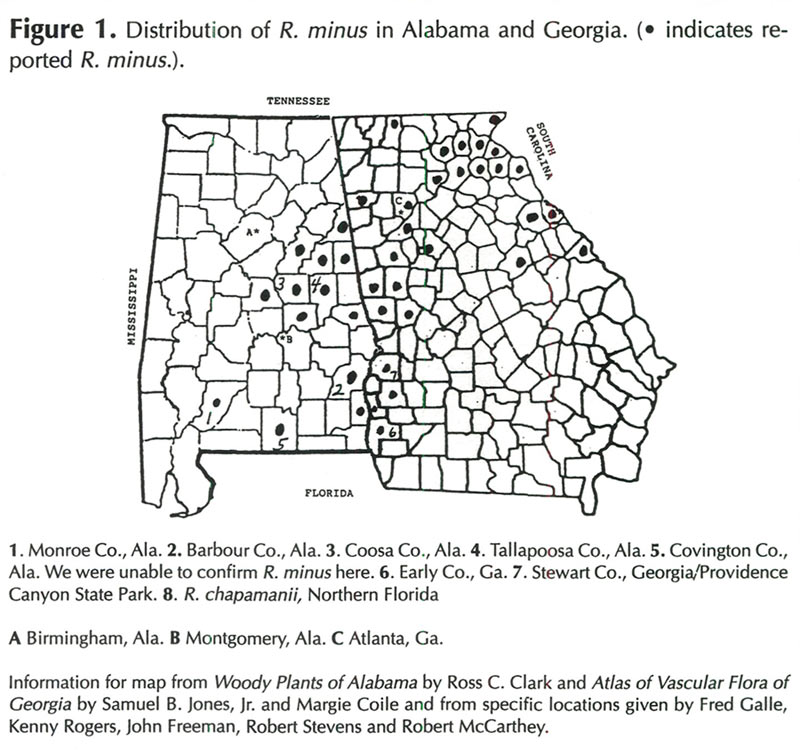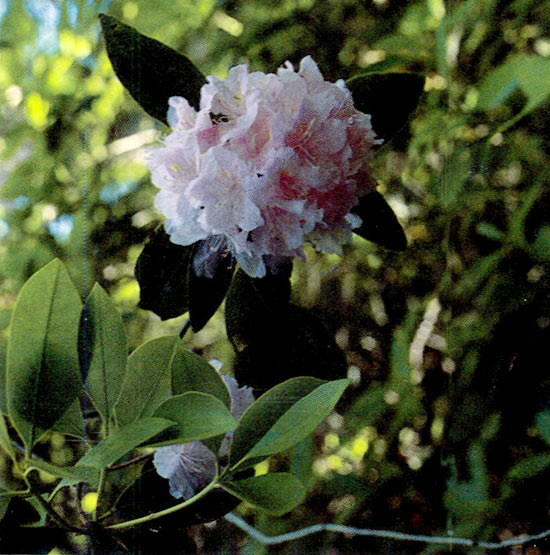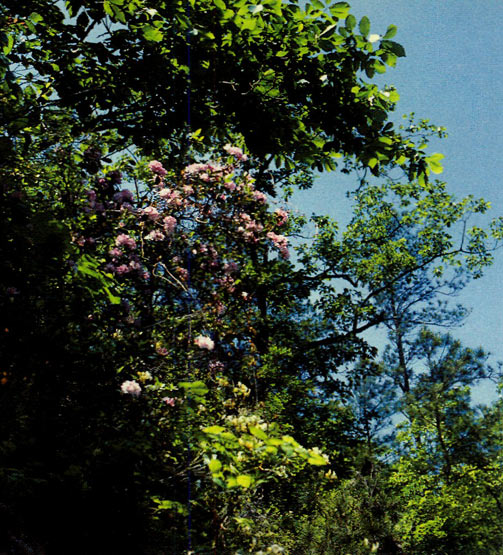JARS v48n1 - A Study of R. minus in Alabama and Georgia
A Study of R. minus in Alabama and Georgia
John T. Thornton, Loyd Cotton
Franklinton, Louisiana
Robert E. "Buddy" Lee
Hammond, Louisiana
We received a research grant from the American Rhododendron Society Research Foundation to study R. minus Michx. as it occurs along tributaries of the Chattahoochee River along the southern part of the Georgia-Alabama border. This is also the area where R. prunifolium (Small) Millais, the plum leaf azalea, grows wild.
S. D. Coleman, a Ft. Gaines, Ga., nurseryman, suggested that the southern Chattahoochee R. minus was distinct horticulturally and more attractive in flower than the type from North Carolina. We had observed a few plants of both types of R. minus . Our impression was that R. minus from the Chattahoochee River were shorter, more compact and earlier blooming by two weeks than those from North Carolina. Flowers of southern Chattahoochee R. minus often have yellow-orange flares while typical flowers of R. minus have green flares.
Our original plan was to locate and study populations of the southern Chattahoochee R. minus in flower. We planned to compare them with typical R. minus and possibly name and introduce superior forms. We also hoped to observe native azaleas and other plants in the area.
We located two populations of R. minus in southwest Georgia and one population in southeast Alabama. We became aware that there were extensive populations of R. minus between Montgomery and Birmingham where the Appalachian Piedmont extends into central Alabama. We also were informed by John Freeman that R. minus had recently been located in Monroe County in southwest Alabama. A distribution map shows R. minus in Covington County in south-central Alabama on the Florida border (Fig. 1).

|
|---|
We went on several trips to study R. minus in flower, but found this method of study frustrating because of weather conditions and distances involved. We found that some populations of R. minus do not bloom every year. Plants growing in dense shade have poor quality, faded flowers that are hard to evaluate.
We then decided to change our strategy and to study R. minus throughout its distribution with particular emphasis on its southernmost locations.
Instead of relying on blooming plants in the wild, we decided to obtain single cuttings and/or single seed pods from 10 to 30 plants in a location. Seed would be blended from each location and a sample of at least 100 plants grown to flowering size. We found that cuttings of R. minus taken any time of the year root easily. Seed gathered as early as August 1 proved to germinate freely.
We have tried to determine the southwestern limit of the distribution of R. minus in Alabama. We spent a day looking for R. minus in Clark County in early May 1989. Clark County is located between the junction of the Alabama and Tombigbee rivers in southwestern Alabama. There we looked for Kalmia latifolia L. in flower since R. minus usually grows in association with it. We found a few colonies of K. latifolia but no R. minus . We found no native azaleas in bloom either.
We have been unable to confirm the existence of R. minus in Covington County in south-central Alabama. We scouted the southern part of the county. Wildlife biologists from the area were not aware of its presence there.
Haines Island Park in Monroe County seems to be the southwestern limit of R. minus distribution in Alabama. Plants we have located grow in rocky soil. They are low-growing, averaging 3 to 4 feet in height. They have not bloomed for the last three years (1989-1991).

|
|---|
We found a large population of R. alabamense Rehd. growing along the Big Flat Creek in Monroe County. These plants seemed to be much taller growing than the type form of R. alabamense from northern Alabama. Many plants were over 15 feet tall with 5-inch diameter trunks. Flowering occurs after the new growth. Flower or petal colors were white to pink with a yellow-orange blotch. The blotches seemed to be more pronounced than in the type form. The flowers were extremely fragrant. We often could smell the flowers before we could find them. Some plants had flowers with heavy substance and may be polyploid.
These R. alabamense bloom from about May 1 to May 21. The R. canescens (Michx.) Sweet growing in the area flower between March 15 and April 15. We have observed very little overlap between the flowering seasons of these two species, although both species showed evidence of hybridization. For instance, some R. canescens have yellow blotches and some R. alabamense have pink tubes.
We have propagated two plants of R. alabamense from the area. 'Alabama Fountain'* is pink with yellow blotch. Another clone, yet to be named and registered, has such a prominent blotch that the flowers appear orange from a distance.
In mid-May 1989 we spent a day scouting Coosa County, Alabama. Rhododendron minus was abundant everywhere. It was in full bloom along with K. latifolia . From a distance, it was difficult to tell R. minus from K. latifolia . On close inspection, R. minus proved to be much more variable in flower color than K. latifolia . Colors ranged from near white to deep pink. Rhododendron minus was always lower growing than K. latifolia . It rarely was over 7 feet tall.

|

|
|
|---|---|---|
R. minus , Coosa County, Alabama Photo by John Thornton |
R. minus , Coosa County, Alabama Photo by John Thornton |
The Coosa County R. minus suffered extensively from a leaf disorder. This disorder caused necrosis of large areas of most leaves and seemed to affect the vitality of the plants. No dead plants were found, however. This disorder seemed to greatly reduce rooting of cuttings taken. The surviving cuttings have not shown any of its symptoms.
We have named two plants from Coosa County. 'Rockford'* is the deepest pink we have seen of R. minus . 'Unity'* is a vibrant pink discovered growing under a medium sized beech tree. There were five or six plants completely encircling the tree. They looked identical in leaf and flower and perhaps had layered from a single plant over a period of many years.
In July 1991 we found R. minus growing near the Lake Martin Dam in Tallapossa County, Alabama. The plants grew on moss-covered rocks overlooking a lake. These plants had much denser scales on their twigs and leaves than other R. minus .
We have also located a population of R. minus near Bakerhill in Barbour County, Alabama. These plants grow along a small spring-fed stream. The soil is quite sandy with no rocks. There were no K. latifolia growing in association with them. The only other R. minus we have found not associated with K. latifolia were in Providence Canyon in Georgia which also has sandy soil with no rocks.
In late April 1990 we observed these plants in flower. The plants were in dense shade from hardwoods and flower colors were mostly light pink to white. It was difficult to assess these plants in bloom because of the dense shade.
We have visited a population of R. minus growing on the Kolomoki Creek in Early County, Georgia, over a period of several years. Kolomoki Creek, where we explored it, is a 25-foot gorge in solid rock with a rapid flowing stream. Rhododendron minus along with K. latifolia grows along its walls and rim. The plants grow 3 to 5 feet tall and get plenty of light.
This Kolomoki Creek colony is the southernmost R. minus we have found. It is within 70 miles of R. minus var. chapmanii A. Gray in northern Florida.
In late April 1990 we visited Kolomoki Creek. R. minus was in full bloom. Flowers were of exceptional quality. The colors ranged from white to medium pink.
We have named two plants from material taken several years ago. 'Kolomoki'* is a seedling having light pink to white flowers with a golden flare. It is a dense spreading plant reaching 3 to 4 feet in 10 years. It is remarkably disease free and easy to establish and grow for us.
'Fort Games'* is an open upright plant with broad flat leaves. The plant originated from cuttings taken in the wild. The flowers are a delicate pink.
Providence Canyon State Park is located 120 miles southwest of Atlanta. This area is referred to as "Georgia's Little Grand Canyon." The park has many spectacular views and geologic formations. The canyon resulted from rainwater erosion across plowed fields which were underlain by deep sandy soil formations. This process started 150 years ago when the forest was cleared for farming and continues today, creating a changing and expanding canyon. The park has many visitors despite its remote location. Rhododendron minus and R. prunifolium have established themselves on the walls of the canyon. No other native azaleas or K. latifolia were seen there.
In late April 1990 we visited Providence Canyon. Rhododendron minus had already passed its peak of bloom. Of the flowers that remained, flower color ranged from white to salmon to medium pink.
There had been heavy rainfall and numerous plants of R. minus were washed into the bottom of the canyon. Rhododendron prunifolium with its large root system seemed to have survived the heavy rainfall better.
Rhododendron minus readily reseeds itself in the canyon. The seedlings grow in sandy soil where there is little organic matter or moss cover. Rhododendron prunifolium in the canyon varies from orange-red to yellow to salmon in color, blooming in July and August.
In future reports we hope to compare plant materials from different locations. Soil and rock samples have been taken from all locations where R. minus was visited, and these will be analyzed and reported at a later date.
Named varieties of R. minus are being sent to the Rhododendron Species Foundation. C & T Nursery will also have these plants available.
John Thornton and Loyd Cotton are partners in C & T Nursery, Franklinton, La., and Robert E. "Buddy" Lee is manager of Acadian Nursery of Hammond, La.
Editor's Note: * Unregistered but not in conflict with a registered name.

